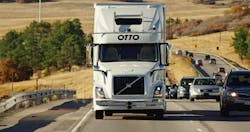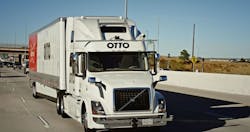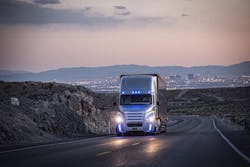Road to driverless trucks clogged with unanswered questions
With nearly daily media reports detailing new breakthroughs of highly automated commercial vehicles (HACVs), it may seem they are almost ready for large-scale use.
Yet a public listening session sponsored by the Federal Motor Carrier Safety Administration (FMCSA) illustrated just how many questions remain to be answered before the technology can become a reality on the nation’s highways.
“There is a gigantic void between what is reality and what is the Hollywood version of what is going on. We are a long, long way from a truly driverless truck, and I think everyone in this room knows that,” said Tom Balzer, president of the Ohio Trucking Association.
This listening session, broadcasted live online, took place this week in Atlanta as part a Commercial Vehicle Safety Alliance (CVSA) forum.
“Our goal is not to impede progress but for us as regulators to try to run alongside development as it moves forward,” noted Daphne Jefferson, FMCSA’s deputy administrator.
The agency is accepting public comments until July 17 as begins to consider regulations and guidelines covering different levels of automation.
Much of the discussion surrounded what rule changes for driver training and hours of service might be needed if there is a shift toward autonomous or semi-autonomous vehicles.
Ognen Stojanovski, part of Uber’s advanced technologies group responsible for last year’s autonomous beer delivery in Colorado by Otto, offered up some of the session’s most specific suggestions.
He said no changes to existing training or safety regulations are needed if someone is required in the driver’s seat when in autonomous mode.
However, new approaches will be needed for fully autonomous trucks – when a driver is not supervising the operation of the vehicle. For example, he suggested allowing drivers to log sleeper berth time while the vehicle is in motion on its own.
“We think it would be highly beneficial for the FMCSA to recognize the fundamental distinction between HACVs that require a driver behind the wheel, which are commonly described as advanced driving assistance systems, and those that do not require any human engagement, often labeled autonomous vehicles,” he said.
Following his comments, Jack Van Steenburg, FMCSA’s chief safety officer, asked if Uber was ready to move forward with truly driverless trucks.
“No, we’re not there now,” Stojanovski replied.
Additional topics over the two-hour session included if autonomous vehicles need decals for easy detection on the road, who is liable if there in an accident involving an autonomous vehicle, how to ensure the cyber security of these vehicles and what maintenance challenges could result from the advanced technologies.
Angelo Gibson, assistant vice president of operations for TL carrier Werner Enterprises, urged regulators to maintain a focus on safety as it weighs the possibilities with these evolving technologies.
“Through automation we want to make sure we keep that at the forefront,” he said.
Danny Hefner, director of safety and recruiting for MCO Transport, wondered if a driverless truck can maintain its lane if it blows a tire or suffers a basic equipment failure.
He also recommended the Department of Homeland Security get involved to ensure the highest level of encryption to ensure cyber security.
Other speakers included representatives of trucking fleet, Volvo Trucks, Daimler Trucks North America, the insurance industry and law enforcement.
About the Author
Neil Abt
Neil Abt is a former FleetOwner editor who wrote for the publication from 2017 to 2020. He was editorial director from 2018 to 2020.


